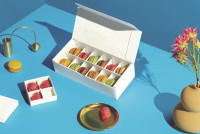Chocolate is particularly sensitive to odours due to its high fat content. Packaging that is in direct contact with it must therefore meet special requirements, explains Marjatta Punkka from the Finnish cartonboard manufacturer Metsä Board.
Foods, and especially confectionery products, place a high demand on packaging: In addition to its ability to encourage purchase at the point of sale (POS), protection of the contents during transport must also be ensured. Fi-nally, a packaging material’s suitability for direct food contact plays a decisive role, since, after all, unpleasant odours should not end up in the product.
The supreme discipline in packaging is chocolate. “Many odorants are fat-soluble”, explains Marjatta Punkka, Product Safety Manager at Metsä Board. “And since chocolate contains a lot of fat, it is particularly sensitive and absorbs volatile compounds quickly. For this reason, it is often used as a simulant when testing sensory properties of food packaging.” Metsä Board uses 120 kg of chocolate each year to test the taste neutrality of its board grades.
Odours can be caused by the board itself, or by the ink, varnish, possible adhesives, or a laminate used on the board. There are many sources of interference that can affect the quality of sweet seduction. To identify them, many companies still rely on sensory evaluation, the so-called Robinson test.
“Odours can be caused by extremely low concentrations of substances,” reveals Ms Punkka. “With instrumental methods, these concentrations sometimes appear insignificant, but in sensory evaluation they are quite perceptible.” Gas chromatography tests and testing according to the Euro-pean standard EN 1230-2 are still used – but always accompanied by a sensory assessment.
Yet, which packaging offers the best safety for direct food contact? In general, packaging solutions made from virgin fibre have advantages over recycled fibre, since their composition is known throughout. “Recycled fibre comes from many different sources,” says Ms Punkka. “This makes quality control a major challenge. Especially in food industry, consistent quality is a must at all times.”
In addition, recycled fibres can contain residues of printing inks, adhesives, varnishes and other chemicals. Mineral oil residues cannot always be ruled out either. For this reason, it is even forbidden in several countries to use recycled fibres for materials that come into direct contact with food. Quality can be better controlled with virgin fibre. “In our process, all chemicals go through a thorough evaluation process that covers regulatory, functional and safety aspects. For example, we don’t use fluorochemicals at all,” Ms Punkka assures. “And we follow the development in food contact materials regulatory field actively.”
But it’s not just the cartonboard itself that plays an important role, further processing does too. To produce high-quality packaging, all processing plants must comply with the same standards. This means, for example, using food-safe, low-migration printing inks and water-based varnishes. These are non-toxic and completely free of UV-reactive chemicals – in other words, harmless even in direct contact with food.
Not printing or finishing the packaging is not a solution either – its use as a marketing tool is far too important for that. It should stand out from the shelf at the POS and encourage consumers to buy. The type of material and the use of certain colours, symbols and fonts, for example, can convey a particularly high-quality image and thus enable premium positioning. Cardboard can be ideal for conveying the idea of sustainability. Virgin fibre cartonboard can be printed and finished to a high standard suited to luxury brands, helping them to convey their brand values at the POS.
How customer-friendly the packaging is should also be considered. Consumers are often willing to pay more for a product that offers added value, such as improved portability or resealability. Metsä Board’s Excellence Centre in Äänekoski/Finland shows how this can work. Optimized packaging is created here that appeals to the senses and can fulfil additional functions. Recent examples created include golf ball packaging that can be turned into an insect hotel, and wine packaging with an integrated holder that ensures that the delicate crackers shipped with it are protected. The design team in Äänekoski combines creativity, expertise and access to state-of-the-art technology to create packaging solutions that are in tune with the current zeitgeist.
This is also the aim of Metsä Board’s design challenge Better with Less (www.betterwithless.org), which is entering its third round this year. Once again, designers are invited and challenged to develop more environmentally friendly solutions for some of the world’s most used consumer goods packaging. Designs will be judged by a panel of experts including influential packaging design professionals from around the world. Entries can be submitted up to and including 1 December 2022.






